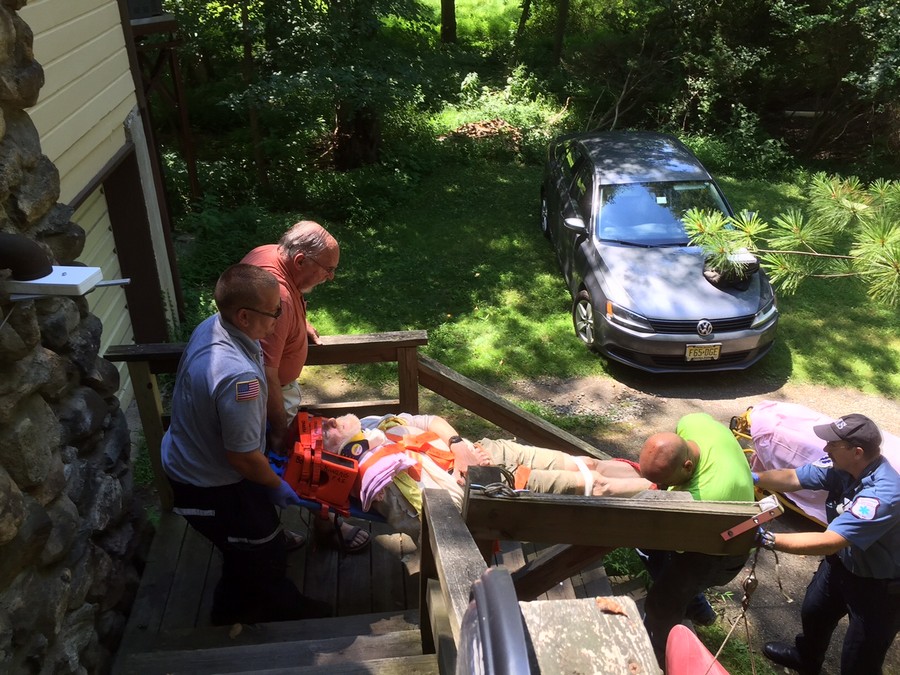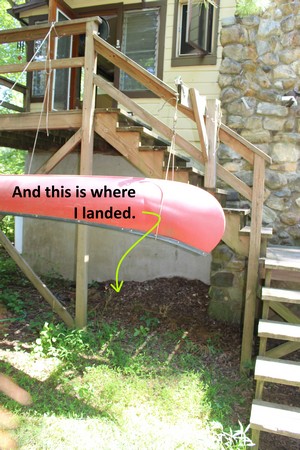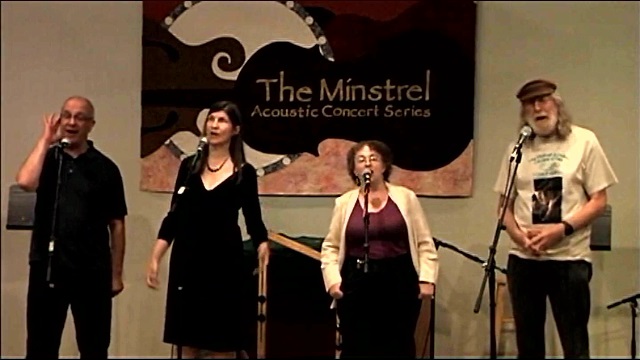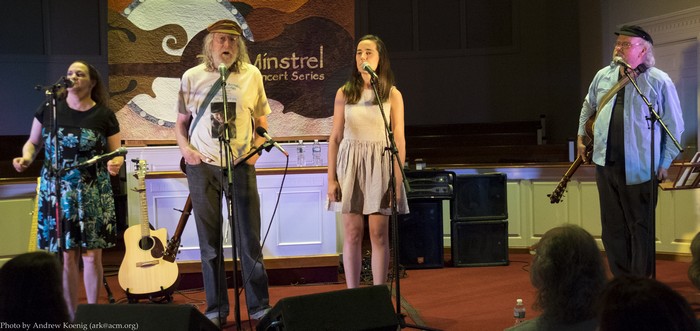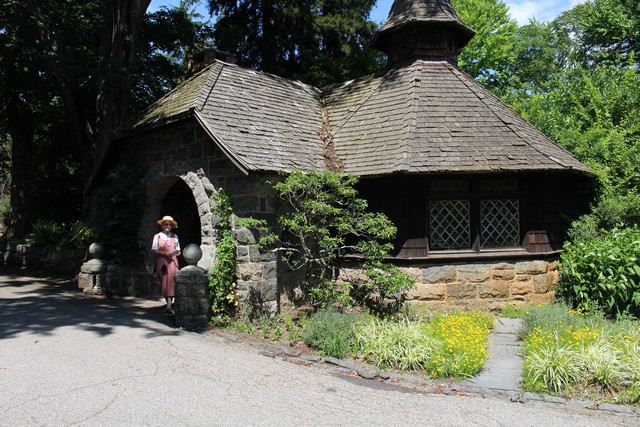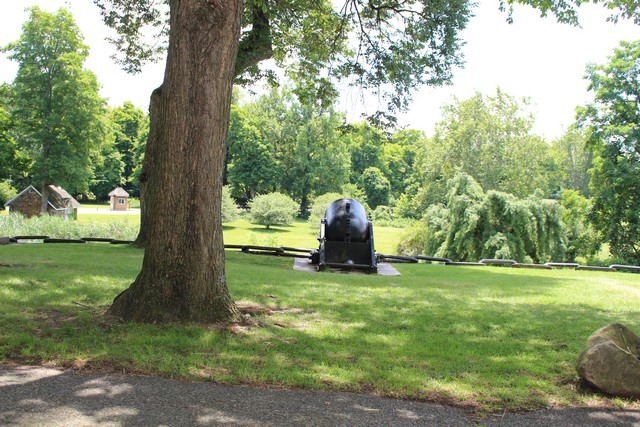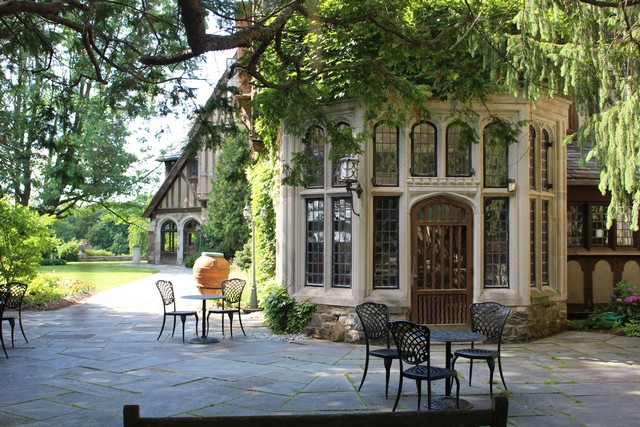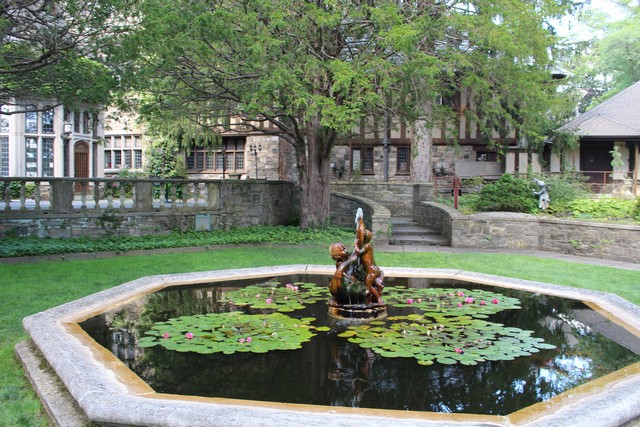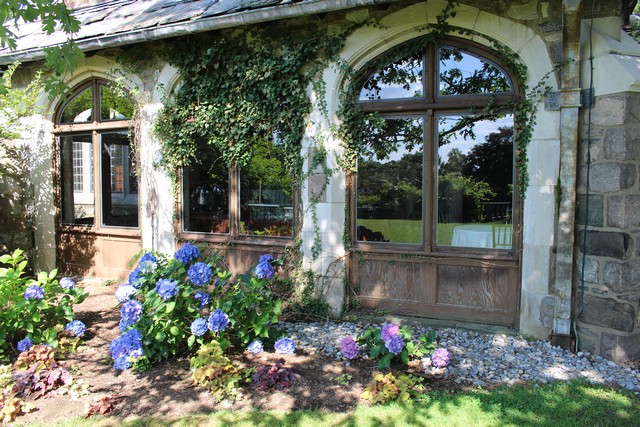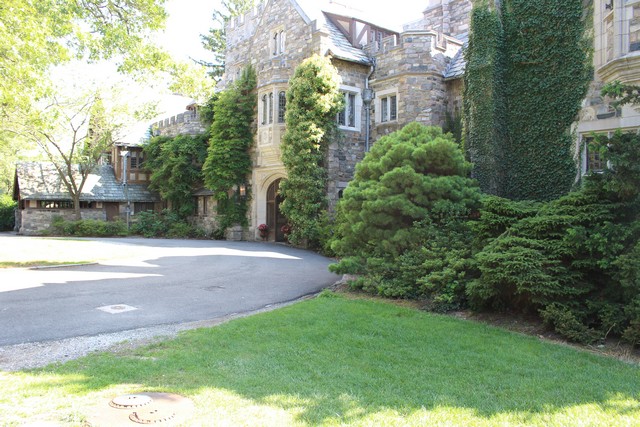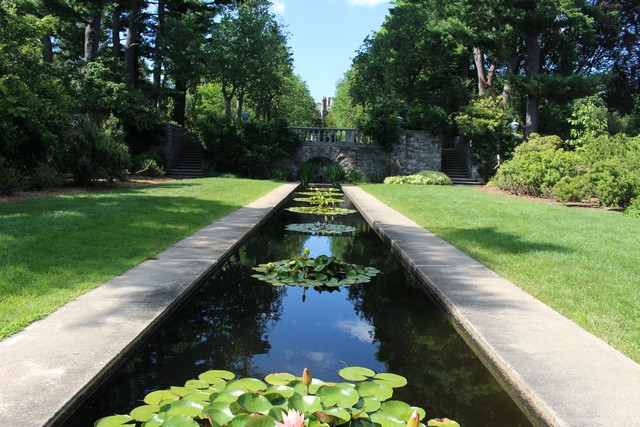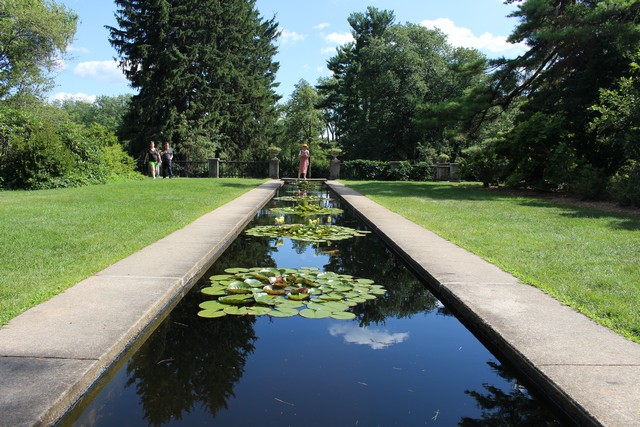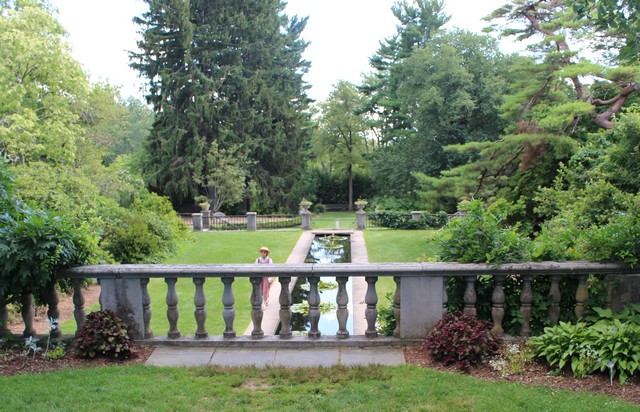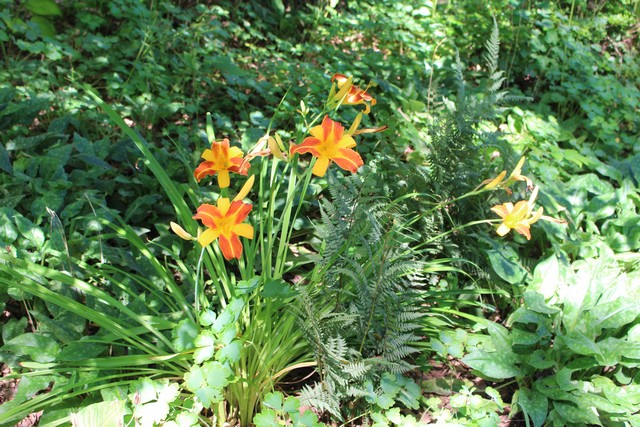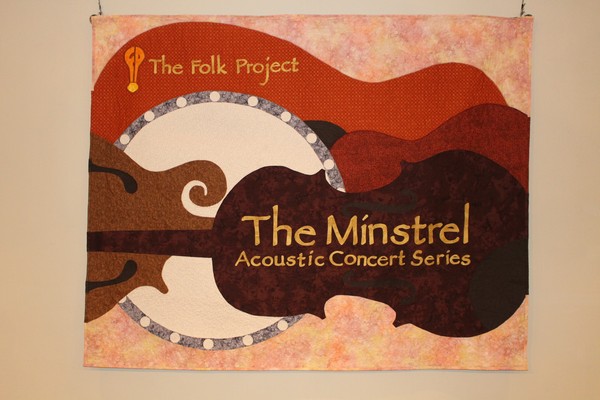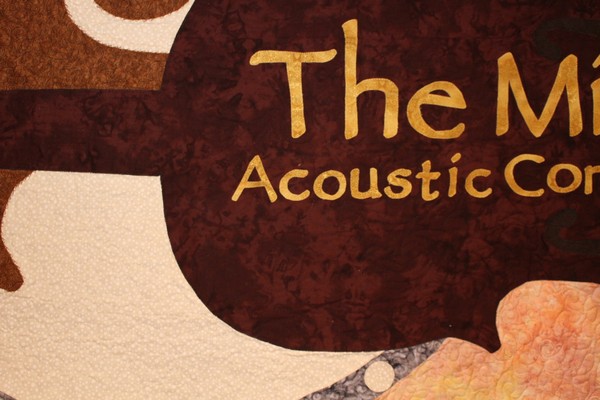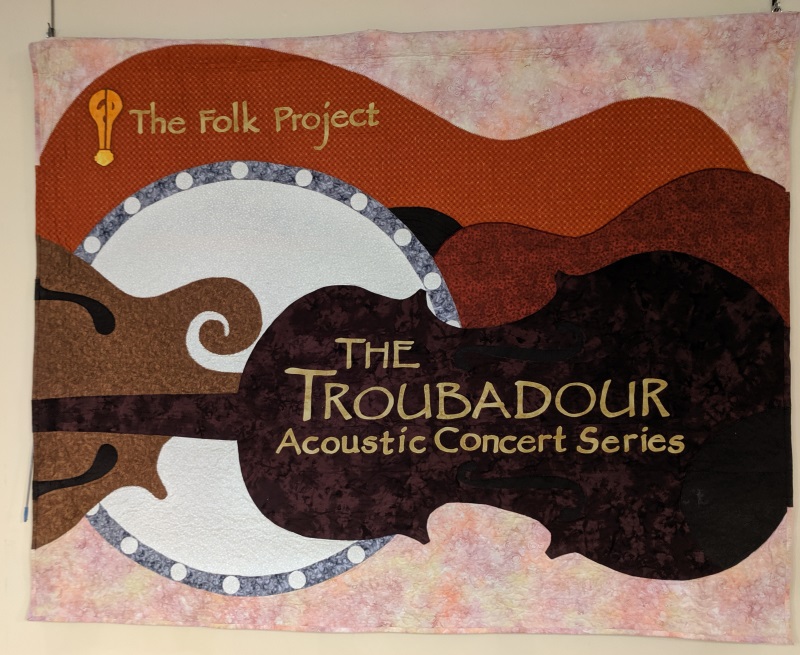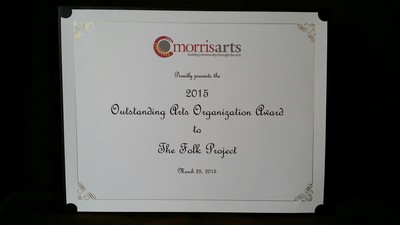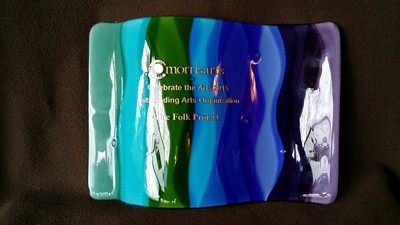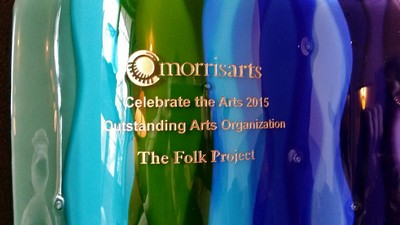November 21, 2015
Woodrow Wilson and Princeton University
I'm probably going to regret posting this. But there is a news story that caught my eye about which I must comment. There are a bunch of folks out picketing the University of Princeton to take Woodrow Wilson's name off a building and remove his statue from the campus because he was a racist.
To these people I ask: Why do you set your sights so low? Wilson?? Wilson is small fry. George Washington was a freaking slaveholder for Chrissake! Shall we tear down the Monument, rename the Capital, take his face off the dollar bill, and grind Booker T. Washington's surname off his tombstone?
And before you accuse me of racial insensitivity, let me point out that Henry Ford was anti-Semitic. Does that mean I should hop on a plane to Dearborn and picket the company to remove his moniker from the car? I got better things to do.
I have no evidence to the following assumption, but I will give you long odds that every president for the first two centuries of this country's existence who was not actually a closet homosexual was a homophobe.
That was then; this is now. We've learned better. If we start re branding everything named after someone whose morals, while consistent with those of their time, do not measure up to those of our more enlightened era, this nation will go bankrupt from paying sign painters. Wilson was born in Virginia and raised in the Jim Crow south. Of course he was a racist. He was a man of his time and place, did as his mammy told, and didn't know any better. But he was also President of the United States, and president of Princeton University. Leave his name on the goddam building, put a footnote on the inscription below the statue, and go focus your energies on the important stuff. Take your satisfaction in the knowledge that today Wilson is twirling in his grave over the fact that there are Negroes attending class in his building.
Postscript, June 28, 2020
This post has long been one of my favorite pieces of writing. I had worked long and hard at the wording, tightening it up and making it pithy and punchy in a style worthy of Jon Stewart. The main point I was trying to make was that historical figures should not be castigated for adhering to the moral standards of their day if those standards do not measure up to those of our times.
And to a large extent I still believe that. Yes, Washington was a slaveholder. But slavery was common in his time throughout the thirteen colonies, and throughout the world. There was enormous historical precedent for the institution. The Romans held slaves. The Greeks held slaves. There are countless examples of slavery in the Bible, which appear to be so ordinary and acceptable that the Scriptures do not seem to find it worthy to remark upon the practice. And the enslavment of people of a particular race or country of origin was common. The concept that “…all men are created equal…”, immortalized in the Declaration of Independence, was a new and radical concept at the time. So it is possible to weigh that (now) negative aspect of Washington against all his positive achievements, and still have him come out positive in the balance.
However, recent events have brought me to reexamine this post. Monuments to Robert E. Lee and Jefferson Davis are coming down across the country, some by official sanction and some by illicit popular action. Christopher Columbus, Theodore Roosevelt, and the Spanish Conquistadors may be next to leave their pedestals. And I heard on the news today that Princeton's Wilson School of Public and International Affairs will soon be renamed the Princeton School of Public and International Affairs. The news article revealed to me some facts about Wilson’s racial policies about which I had been unaware. (Among other things he re-segregated the Civil Service, which had been somewhat integrated before his administration. See the Report of the Trustees of Princeton University.)
My inclination to forgive people who adhere to the moral standards of their time remains largely unchanged. In my opinion, Washington’s achievements in bringing the Thirteen Colonies to nationhood outweigh his engaging in the then-common practice of slavery. Same goes for FDR’s leadership of the country through the Great Depression and World War II, even though his reputation is besmirched by the Japanese internment camps he instituted. Mark Twain, in "Huckleberry Finn", an international best seller in which a Black man is for the first time (for a White author) given a fully fleshed-out and sympathetic human character, still calls him a “nigger”. (A dialectal pronunciation of “Negro” in a book written in dialect.) I can let that slide. It’s not all, if you’ll forgive the expression, black and white. There are balances to weigh.
Yet, there are still some people and things that fall short in the balance. Hitler raised his country out of the catastrophic depression following World War I. You won’t see any statues of Hitler in Germany today. Lee and Davis fought valiantly for the Confederacy. But the sole reason for the Confederacy’s coming into being was to preserve slavery. They were honorable men in service of a dishonorable cause. Sorry. Take ‘em down. The Confederate Battle Flag may honor “Southern Heritage”, but in my opinion, it is in large part a dishonorable heritage. And knowing what I now know about Wilson, I’ve changed my mind. Rename the buildings. Take down the statue.
Damn shame, though. I really liked the language of my original post.
September 7, 2015
Fame
My face is is a relatively familiar one. Relatively, being the operative word. It's certainly a distinctive face, and one that people remember. People will recognize me around town or in the supermarket occasionally, either from my presence at the Minstrel, or from having seen me perform. There was one incident that happened to me a number of years ago I like to remember. At the time, the New England Folk Festival (NEFFA) was in Natick, Massachusetts, where my brother Saul, coincidentally was also living at the time. It was a great arrangement. I could hang out and dance all day long at the Festival, and then drive 5 minutes and jump into my brother's hot tub. One year, I decided to take Saul and his wife out to breakfast on the Sunday of the Festival. We went to a local eatery, where there was a small line of people waiting to be seated. Many of them were, by their garb, obviously other NEFFA attendees. One of them turned to me, stared for a moment, and then asked, "Are you Mike Agranoff?" Impressed the hell out of my brother!
Now that sort of thing can go to one's head. But I will always remind myself of another incident from a few years earlier that keeps it all in perspective. For a few years during the 80s, there was the Waterloo Folk Festival not far from where I live. It was run by a Colonial Era Restoration park called Waterloo Village. It had a fairly impressive lineup for the evening concerts with luminaries from the 60s and 70s. But for the daytime events they booked a bunch of local acts, one of which was me. And so that's how I happened to have backstage access, where I was sitting and practicing the concertina. And Arlo Guthrie walks up to me and asks, "I've always been curious about that instrument. Can you show me how it works?" "Well, sure, Mr. Guthrie," I stammered. So for ten minutes, I gave Arlo Guthrie a concertina lesson. We were so intent on the lesson that neither of us noticed that a photographer named Thom Wolke snapped a photo of us. And Lo, the next issue of Sing Out! magazine comes out, and there is a photo of "Me 'n Arlo". So I happily brought the magazine into work to show everyone there was some sort of credence to my nocturnal wanderings. And to my dismay, three quarters of the people at work didn't know who Arlo Guthrie was.
It all serves to put things into perspective. Every time I start to think that maybe I'm somebody important, I think back on that to remind myself of what a little fish in a little pond I am.
August 3, 2015
Oops!
|
My trip from my house to the ambulance. |
|
 Departure |
Landing |
Monday morning I was shifting some boxes on my 2nd floor deck, and stepped back off the edge. I fell 10 feet, landing on a fairly soft pile of leaves. Nonetheless, I was injured, blacking out for a few minutes. Things didn't feel right inside. I managed to go upstairs and call Mark Schaffer for help, hoping he could take me to the hospital. As things progressed, we decided we would be better off to get professional transport. Mark called 911, and a large crew of police, EMTs, and various other folks arrived, and secured me to a board, and carried me off to an ambulance, and thence to Morristown Memorial Hospital. A number of X-rays and MRIs later, it was determined that I had fractured my clavicle and a couple of ribs. No spinal damage. No dislocated shoulder, as I had feared.
I'm home and mobile, but I will not be playing any guitar for a number of weeks. I'm not in any pain as long as I don't mistreat my injury. Don't even need pain killers. I've been given a sling, which makes it difficult to type. Makes it difficult to do a bunch of things. I had needed help putting my pants on. I'm learning to use the mouse left handed. I swapped cars with a friend whose car has an automatic transmission to make driving easier, but I've so far managed to catch a ride from others, so I don't have to use it. Even with the automatic, driving is uncomfortable and probably dangerous. But it looks like I will have a complete recovery in 4 to 6 weeks. I've had to cancel 3 August gigs, but should be back in business by my gigs in September.
I've arranged with a contractor to build some railings for that edge of the deck.
Postscript: August 14:
Less than two weeks after the accident, I am recovering nicely . I haven't worn the sling for a week. I can dress myself without help and get into and out of the bathtub. I have my own car back, and can deal with the manual transmission, although I'm still catching rides when I can. 3 days ago I tried playing guitar; I've found that my dexterity is just about where it was before the accident, but the strap is uncomfortable where it goes over my shoulder blade. I've reinstated one of the cancelled gigs this upcoming Sunday: the Crossroads Festival on Long Island, where I will be serving as emcee, rather than performing. Things are going well.
Postscript: September 21:
I'm back to about 95%, and should be fully healed in a couple of weeks. Been doing Physical Therapy. I got a "Glad You're Better" note from my friend Bill Neely, congratulating me on my speedy recovery from the fall which had left me with an "ill-tempered clavicle".
Postscript: September 27:
I may be clumsy, but I'm not stupid.
: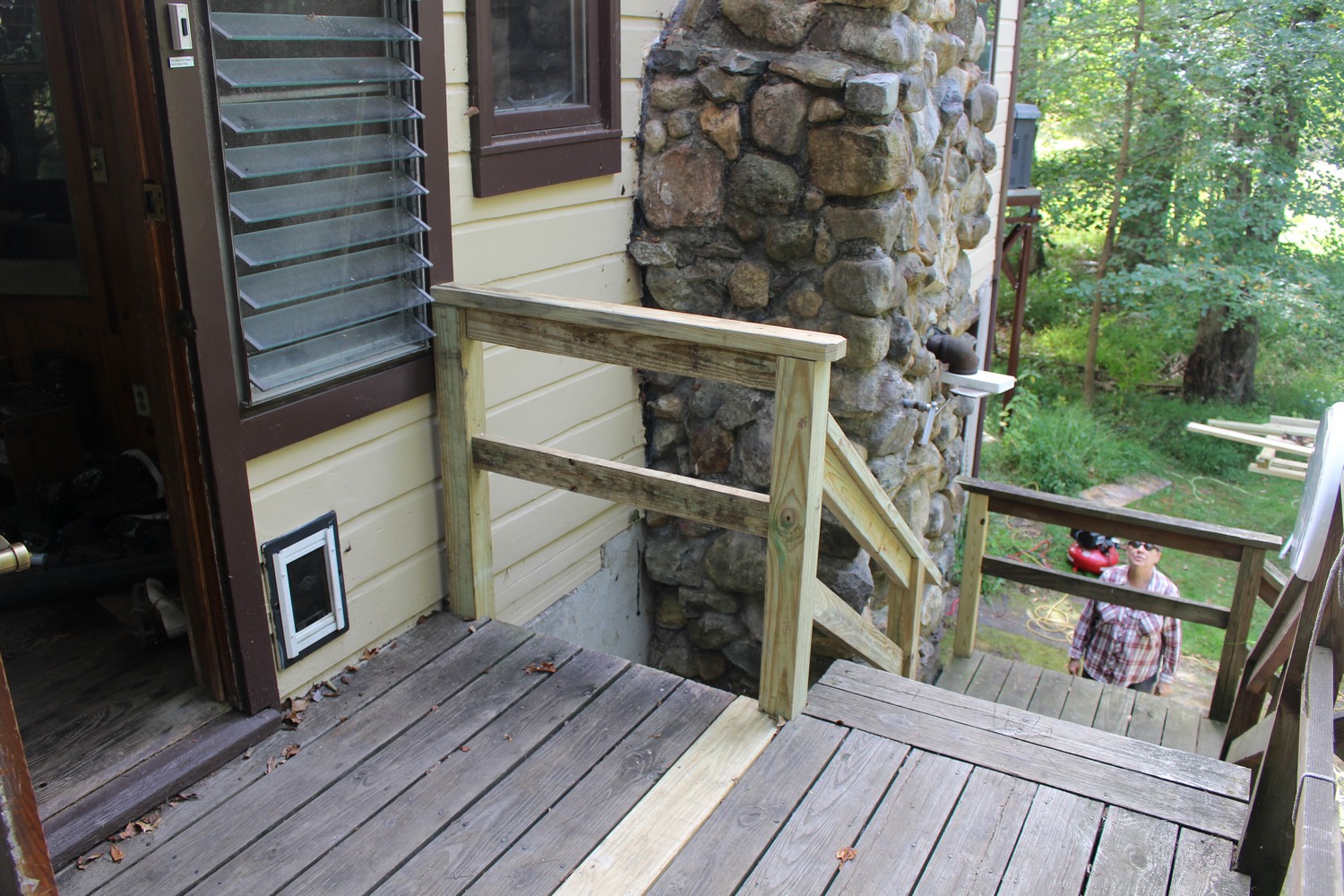
July 24-25, 2015
Big Birthday Weekend
July 25 was 40 years to the day from the very first concert ever produced by the coffeehouse that was to become the Minstrel Acoustic Concert Series. And I attended that very first concert on my 30th birthday. So I'll leave it to you to do the math. So not only was the 25th a double birthday, but the Minstrel also had a double celebration. On Friday the 24th we celebrated as we do every year on the Friday closest to the 25th: with our annual Birthday Show. And on Saturday the 25th, we held a special Minstrel concert featuring Tom Paxton.
Friday, July 24: THE BIRTHDAY SHOW
Left to right: Mark Wolkoff, Lindsey Meyer, Amy Livingston, and me singing "Barrett's Volunteers".
Click the photo for the video. (Video courtesy Bill Henderson)
The Birthday Show is, as far as I know, unique among all folk clubs. It is a concert featuring about 40 to 50 Folk Project member musicians in semi random combinations. On July 4, the Project holds a picnic for all its members. And at that picnic, all members who wish to perform in the Birthday Show put their names on index cards, which get shuffled, and dealt out into random duos and trios. There are 20 groups so-formed. Each group then has the next 3 weeks or so to work up one song per group. They may add additional members to the group of their own choosing, provided those "ringers" are also Folk Project members. The show then consists of those 20 songs.
We've been doing this since around 1980. When it first started, the performers were chosen by invitation. But soon thereafter it was opened up to all performing members. I initially opposed that, but have come to see the wisdom of those who overruled me. Perhaps the music would be better if only the cream of the crop performed. But the enhanced camaraderie and spirit of the the organization resulting in opening it up to all members far outweighed that. And I've seen some amateurs really rise to the occasion, and pull something off that they'll remember all their lives.
This year, I was paired up with Mark Wolkoff, who is an excellent harmony singer. When I found that out, I was delighted, because I had a song in mind that cried out for harmony.
A little background: A year ago, Barrett Wilson took over as the Minstrel's Volunteer Chairman. Some months afterwards, a friend Murray Spiegel came up to me and said "You gotta write 'Barrett's Volunteers'!" I smacked myself in the forehead and said, "OMG, how can I not?!"
A little more background: "Barrett's Privateers" is a song well known in the folk community. It's a big lusty acapella sea chantey written by Stan Rogers, one of the icons of the contemporary folk world. (Here's a link to the original if you aren't familiar with it.) I've written a few good parodies, so I made a few attempts at Murray's suggestion. But I couldn't think of a good story line to tell that paralleled that of the original, so I never got very far. So I asked my friend Larry Kaufman, who specializes in parodies if he would give it a whirl. He wrote a pretty good one, but he wrote it about the Folk Project Getaway, not the Minstrel. But he gave me the key to the parody. Rather than write a long story, he wrote one verse about each volunteer position. Once I got that structure, the song almost wrote itself. It's mostly chorus, and there are only three lines to write for each verse. And only two of them have to rhyme. I knocked it off in about an hour. Oh yes, and the reference to "ticks" in the song: Those are the credits our volunteers get for every show they work, redeemable for a later free concert admission.
We filled out the group by adding Lindsey Meyer, another natural harmony singer, and Amy Livingston, another good singer, and Barrett's Assistant Volunteer Chair. We learned it. And come show time, we knocked it out of the park! Click here for the video. We brought the house down.
Saturday, July 25: THE MINSTREL'S 40th ANNIVERSARY CONCERT FEATURING TOM PAXTON
|
Left-to-right: Christine DeLeon, Mike Agranoff, Jean Rohe, and Tom Paxton singing "Time Has Made A Change". |
|
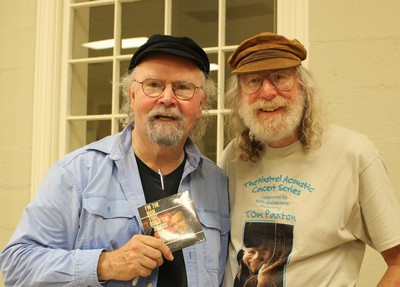 Tom and me |
 All the performers: Left-to-right: Geoff Bartley (Tom's accompanist), Christine DeLeon, Tom Paxton, Mike Agranoff, Jean Rohe, and Liam Robinson (Jean's co-performer) |
The celebration for the Minstrel's 40th Anniversary started over a year ago. I knew we wanted to do something pretty significant. On the 30th, I arranged a Magical History Tour, carpooling a bunch of people on a tour of all the venues the Minstrel occupied during its existence. I wanted this one to be bigger, and accessible to more people. So I figured we would do what we know how to do best: put on a concert. But featuring whom? It would need to be someone bigger than the usual Minstrel fare, but still representative of the kind of music we present. It took about 30 seconds to come up with Tom Paxton. I called up his agent, and proposed the idea, and it turned out he was available on Saturday, July 25th, 40 years to the day from the Minstrel's very first show. And my 70th birthday. And, to add further significance to the event, it turned out that this was to be Tom's last tour before retiring from full time performing. It seemed the stars were all falling into alignment.
And we got some ideas on how to further enhance the event. The idea was put forth to make the event a gift to our volunteers. So we set up the ticket pricing structure to be $30 for general admission, but for about 150 invited Folk Project volunteers over the course of our history, we offered a special ticket for the regular Minstrel admission price of $9.00. (Eventually 71 people took advantage of that offer, some coming from as far away as North Carolina and Washington State, whence they had since moved.)
Of course we needed a larger hall than the Minstrel's usual 200 seat venue. I inquired about the Sanctuary Concerts' 450 seat venue at the Presbyterian Church of Chatham Township. As it turned out, Sanctuary had hoped to present Tom themselves this year, and were mightily disappointed that I had secured him before they got around to it. So we decided to join forces, and coproduce the concert with Sanctuary. They were gracious enough to do it under the Folk Project's auspices, considering the significance of the anniversary. But they smoothed the way with the negotiations with the venue, and provided much of the on-site volunteer work in exchange for early ticket availability to their regular attendees. As it was, tickets went on sale to the Folk Project and Sanctuary mailing lists in late March, and we were sold out almost before they went on sale to the general public in mid April.
For the format of the concert, I decided to precede Tom's performance with short 2-song opening sets from three Folk Project member musicians: Christine DeLeon to represent our current crop of performing members, Jean Rohe (who first showed up at age 8 in the mid 90s as part of her family band) to represent the middle years, and myself to represent the founding generation. That would be followed by two full length sets by Tom. Tom graciously agreed to both the format and the reduced price for our volunteers.
The press coverage started at the end of June. I had a 45 minute interview with Bill Nutt of the Morristown Daily Record (the county's major paper). The entire interview was aired on WNTI radio on July 5, which you can listen to here. He took that interview, and combined it with information gleaned from interviews with three Folk Project board members and a half dozen performers, including Christine Lavin, happy Traum, and Tom Paxton himself, and wrote an article that appeared in entertainment section of both the Record and the Courier News on Sunday, July 19, entitled The Minstrel Turns 40 -- and a Minstrel Turns 70. In addition, he got a paragraph or two of quotation from all of those performers that was published in the printed edition of the papers, but not the online version. That is reproduced below.
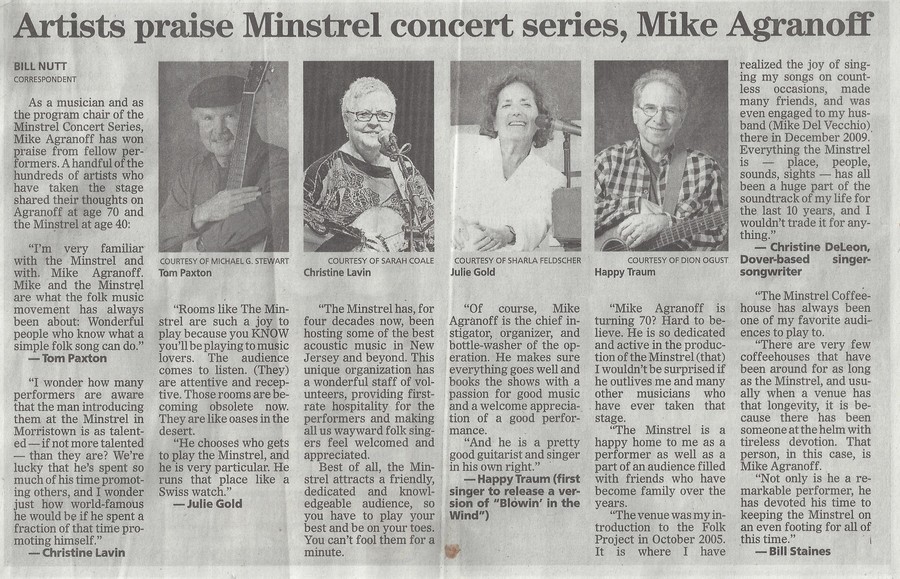
Then on Friday, July 24, yet another article appeared in the TGIF section of the Daily Record about the Birthday Show slated for that evening, featuring all Folk Project members described at the top of this Blog entry.
On the day of the concert, things got a little hectic as we ran around to take care of minor details we had not envisioned in our new environment. But it could not have gone off better. I emceed, and gave a little 5-minute overview of the Folk Project for the benefit of the non-Projectiles in the audience. I then introduced Christine DeLeon and Jean Rohe, who were very well received for their short sets. Then I came out and performed Bob Coltman's "Before They Close The Minstrel Show", from which the Minstrel got its name, with a brief history of how that name evolved embedded within the song. (The same performance I gave at the MorrisArts Awards Ceremony back in March, which you can see here.) And then I brought Christine and Jean back, and together we performed the traditional "Time Has Made A Change" acapella. And (by prearrangement) we were joined in the middle of the song by an unannounced Tom Paxton. Here's the video. That was followed by a long sustained applause that really touched me. And finally Tom Paxton took the microphone and performed two brilliant sets of music, mixing new songs with old favorites, and accompanied by Geoff Bartley on guitar.
It was a wonderful culmination to12 months of preparation, 40 years of Minstrel, and 70 years of living. And it probably won't surprise anyone who knows me that at the end, my reaction was, "OK, that went well. What's next?"
July 19 - 22, 2015
Staycation
In past years, Jenny and I have gotten together to take some sort of trip for a vacation. But this year, our schedules were not compatible for an extended trip at the same time. So she came down for a 4-day visit just before my birthday, and we would see some of the local sights. She combined the trip with a musicale that some of her Early Music buddies had set up in New York City on Sunday the 19th. The plan was that she would meet with them early in the day to rehearse, and I would join her to see the performance. Or part of the performance at any rate.
The event was to be an all-day Early Music binge; an indulgence about as close as recorder players and motet singers come to wanton bacchanalia. The festivities were to start at 3:00 with a series of short presentations by all present. At 6:00, after the briefest interval for sustenance, it would continue with a three hour concert performance of the Monteverdi Opera "Orfeo", followed by Renaissance jamming deep into the night. I do enjoy Early Music, but in moderation. So I determined that I would listen to the short performances in the afternoon, and then take my leave before the opera.
According to the flier I got, the festivities would take place at an address in Washington Heights in upper Manhattan. This turned out to be an older but quite classy condominium apartment complex with a stunning view of the Hudson River and the George Washington Bridge, which I had just crossed. However when I arrived at the address, I was presented with a locked lobby door and a phone. I lifted the receiver, went through the automated menu, and was eventually patched through to the apartment. "The party you have called is unavailable. Please leave a message, and we will return your call as soon as we can."
I stood there in the vestibule with my bottle of wine at a loss as what to do next. The address on the flier was my only contact for the event. Perhaps the phone in the apartment was set to silent so as not to disturb the music. Jenny has a cell phone, but she never turns it on unless prearranged. I waited 15 minutes and tried the lobby phone again with the same results. So I turned around and drove home.
Jenny showed up at my door on Monday morning, wondering what happened to me. As it turned out, the event had been held in a semi-public function room of the condominium, not 100 yards from where I had been standing in the lobby. The flier had been written to a targeted audience of regular attendees of such events, and assumed the reader would know about it. Well, it had been a lovely day for a drive.
But we still had a few days to enjoy with each other. So we went to Ringwood State Park, up near the northern tip of New Jersey near the New York State border. The park boasts two restored manor houses, Ringwood Manor built in the early 19th Century, and Skylands Manor some 100 years later, and their attendant gardens.
Ringwood Manor had been occupied for a century by magnates in the iron mining industry, including Cyrus Field, with whom I was familiar as the prime mover in the laying of the first Transatlantic Cable.
|
A too cute gatehouse with an equally cute Jenny |
Some of the products of the foundry of the original owners: a cannon and an iron chain, (falsely) thought to have been the one laid across the Hudson to block British ships during the Revolutionary War. |
There were no photos permitted inside the house. The docent was quite knowledgeable, and a good tour leader. I was fascinated by the technical aspects of upper class lifestyle of the 1820s. We puttered around the grounds for a while, and then got back in the car and drove 10 minutes to the Skylands Manor section of the Park.
This was a considerably newer and fancier edifice with extensive grounds and gardens recently refurbished.
|
Skylands Manor |
Skylands Manor |
Skylands Manor |
Skylands Manor |
|
Butterfly. |
Reflecting pool from the far end. |
Reflecting pool from the near end. |
Reflecting pool from the bridge. |
|
Garden |
Garden |
Stuff in the garden |
More stuff in the garden |
And the next day we lazed around the house and walked the neighborhood. Just as we might on an off-day on vacation.
|
Me in the river behind my house. |
Jenny |
June 6, 2015
New Stage Backdrop for the Minstrel
|
Overall view |
|
|
Detail: "The Folk Project" |
Detail: "The Minstrel" |
Back in January we had a minor tragedy at the Minstrel. We lost our old "Minstrel Coffeehouse" banner that used to grace the back wall of our stage. It was a batik creation with a cat-tail motif created by Faith Kindness, a Folk Project member, that we'd had since our tenure at the Somerset County Environmental Center in the late 90's. Due to a miscommunication between the Morristown Unitarian Fellowship and their own custodial staff, the banner was inadvertently discarded as part of a general clean-up campaign.
When they found out about it, the MUF administration was mortified, and extremely apologetic. We independently gave it some thought, and independently came up with the same solution: that MUF would find someone among their membership with the appropriate needlework skills to make a new banner for us. We set to work, asking one of our resident graphic artists, Deborah Graham, to create a design, which would be rendered by a crafter from MUF. That crafter was Beth Wilson, and her creation was publicly displayed first at our Spring Getaway, and then to a capacity crowd at the Minstrel at the May 29 show with Brother Sun.
The final product is spectacular. The design is classy and beautiful, and the execution is breathtaking. The photos do not do it justice. This is an artifact. A museum piece. Even the backing (not shown) is gorgeous. Our profuse thanks to Beth and Deborah, and especially to the Morristown Unitarian Fellowship who more than made good on an unfortunate mistake.
Postscript: July 20, 2019
Early in 2019, Alison Miller, the Minister of the Morristown Unitarian Fellowship brought to our attention some rumblings from the Congregation concerning the name of our series, "The Minstrel Acoustic Concert Series". Recent news stories involving some Virginia politicians appearing in blackface in their youth raised the spectre of our series' being connected somehow to the "minstrel shows" of the 19th and early 20th Century American entertainment format. These were often characterized by white musicians in blackface whose performance included racial "humor" and parody of African American speech patterns.
This was not a new issue. In its early years, the Minstrel Acoustic Concert Series was named The Minstrel Show Coffeehouse (after a song by 70s folksinger Bob Coltman) until one of the Folk Project's then Board members pointed out the connection, and we changed it. Alison did not specifically request that we change the name again, but merely wanted to point out that there were some concerns raised.
My initial reaction was to keep the old name, emphasizing the original definition of the word "minstrel" as the traveling musician of Medieval Europe. We could do that with appropriate graphics and other means. But after reading a post in the Unitarian Fellowship's Facebook page by a black member of the congregation, I changed my mind. I came to understand that offence lies in the ear of the beholder (if I may mix metamorphors), not in the intent of the offender. And that sometimes "politically correct" is also just plain "correct".
After a lot of haggling and discussion the Board decided to change the name to "The Troubadour Acoustic Concert Series", or just "The Troubadour" for short. The actual mechanics of changing the name were massive. There were over 1,000 instances of the word "Minstrel" on our website that all had to be manually checked to see if a global search-and-replace was appropriate in each case. There were publicity releases to be sent with explanations to scores of press outlets and mailing lists. All of our past performers (almost 1,000) and their agents needed to be informed. And we all had to erase "Minstrel" from our minds in day-to-day speech. And that cleansing probably won't be complete for at least a decade. (Someone suggested a kitty where we all had to put in a quarter every time someone uttered the "M"-word.)
One of my biggest concerns was that beautiful banner that graced our stage since 2015. There it was, "Minstrel" in gold and brown in letters 8 inches high. What would become of that. I called up Beth Wilson, who created it. She thought it was salvageable, if she still had the fabric, and the font. A quick search showed that she did have both. It wasn't an easy job. The letters were not only sewn on, but bonded with some adhesive. But they did come off with a lot of effort. And an application of a patch of brown background fabric to cover the portion of the fiddle disfigured by the removal of the old lettering left an unsullied space upon which to apply the new name. Yay Beth! Even a close examination will not provide a clue that it ever read anything other than "The Troubadour Acoustic Concert Series".
March 26, 2015
MorrisArts Declares Folk Project "Outstanding Arts Organization of 2015"
Last night the Folk Project was honored by MorrisArts (the Morris County Arts Council) as the Outstanding Arts Organization of 2015. The award was presented at a ceremony in the Bickford Theater of the Morris Museum. We received a certificate and a very snazzy glass sculpture for a trophy. The award was given to recognize four decades of providing high quality and affordable music to the Community, in anticipation of the Minstrel's 40th anniversary coming up on July 25.
About 30 Folk Project members were included in the audience of maybe 125 or so. And the Folk Project also added some unexpected spice to an otherwise staid evening by providing some incidental music to the occasion, including Jean Farnworth playing harp as people entered the auditorium, and an ad hoc ensemble of Kris Lamb, Diane Perry, Hen3ry Nerenberg, and Frank Sole doing a bang-up job on some dance music at the end of the evening. (They may have gotten a paying gig out of that freebie appearance.). And during the awards presentation, I got to sing to the audience.
One of the other honorees at the ceremony was an organization that promotes Art in Boonton. They foster a number of galleries on Main Street, promote art in public places (Dog Daze of Summer: Life size fiberglass statues of various dogs painted and decorated by local artists, and displayed in front of various businesses, stores, and public places on Main Street in Boonton.) It was interesting to find out some of the background behind that event in my home town.
I have always looked askance at anything with the word "Arts" in the title as being sort of pretentious and fuddy-duddy. I may be backing down from that opinion somewhat. Prior to last night, I had quipped about our Award that, "It, and $2.75 would buy us a ride on the Morristown Subway." But in retrospect, 40 years of a concert a week is indeed an achievement. And while I am probably the spark plug that has driven this thing all these years, it and I would never have lasted this long without the enormous support of an effective organization and huge volunteer pool that is the Folk Project. In my travels as a musician, I've seen so many volunteer-run concert series run by half a dozen or fewer stalwart individuals that always seem on the verge of teetering on the edge of burnout. Yeah. The Folk Project really deserves this recognition, and I'm proud of them / us. Even if there isn't any Morristown Subway.
March 19, 2015
New Old Piano
I have a new addition to my instrument collection. (I shouldn't really call it a "collection". That implies a house stuffed with instruments. I tend to find one that I like, and then who needs another one?) This is a Steinway full upright from around the turn of the last century. And in fact we aren't really sure when it was built. According to the serial number referenced in the piano tech's book it is from 1898. But cast into the frame is the legend "Pat. Pending 1903".
This is the 3rd piano I've owned. When I moved into my house I brought with me my grandmother's Chickering baby grand, that had lived in my parents' house throughout most of my childhood. It was a very nice instrument, but really too big for my little bungalow. 6 months after I moved in, the Rockaway River, that normally borders my back yard came to visit (See Blog entry of March 11, 2011, "God Willin' An' The Crick Don't Rise"), and put water up to the keyboard. That pretty much ended its career as a musical instrument. And despite two restoration attempts, it pretty much served to hold the rug down for about 15 years.
Finally sometime in the early 90's, I decided I wanted a piano, and found what appeared to be a really nice 1917 Bechstein upright. The Bechstein name is not well known in this country, but in Europe, its reputation is on a par with that of Steinway. And as a bonus, not only did I now have a great instrument, I had a bigger living room. And it was a great instrument...when it was in adjustment. But it would go radically out of adjustment with changes in humidity. And since I live on a riverbank, and heat with wood in the winter, the humidity changes radically with the seasons. And so the action would periodically vary from the hammers giving double-hits on the strings in the summer to coming to rest on the strings when the key was depressed in the winter. And would sometimes require two or even three adjustments during the spring and fall transitions.
I got so sick of the thing being unplayable that after a while, I stopped playing it. I toyed with the idea of getting a Steinway. I even went to a special "tent sale" that Steinway set up in Madison, NJ a couple of years ago. There were row upon row of new grands, baby grands, plus some uprights and spinets. With the size of my living room, I concentrated on the latter. But I was extremely underwhelmed by everything I saw or played. The sound was nothing to write home about, their actions were stiff, and their appearance was plain to the point of being stark. And the prices were off the charts. I'm sorry, the only thing I was getting for five figures was the Steinway decal on the key cover. I passed.
But last summer, my piano tech told me about this old Steinway he had acquired. Its action needed a lot of work to bring it up to playable condition, but the soundboard and frame were in good shape, and the sound was impressive. Plus, he had a suggestion for me. There is a new outfit that manufactures piano actions out of carbon fiber, specifically designed for a particular make and model of instrument. And they had one available for this model Steinway. The idea intrigued me. I've always preferred a real mechanical piano to an electronic one, but the mechanical ones required routine servicing. This new action would not wear, or go out of adjustment like a wooden one. Old design and new materials combining to the best of both worlds. So I sprung for it. There was a long gestation period, as the new action had to be made to order. But it's finally arrived. I actually dreaded its arrival. I am so out of practice that I'm going to practically have to relearn my entire repertoire from scratch now. I've started. It's nice to have a good instrument.
February 20, 2015
Practical Science?
My house, when I first bought it was a one storey summer cottage that had been winterized to some extent, whose back yard bordered on the Rockaway River. It wasn't long before I came to the understanding that from time to time, it would be be my front yard that would border on the Rockaway. So I undertook to raise my house to avoid these unwelcome watery visits. When the job was done, I had converted what was a crawl space into a garage, which occupied the entire footprint of my house. (See photo) While that pretty much solved the problem of flooding, it created a new problem: Frozen pipes.
Before I had raised the the house, enough heat would leak through the floor to keep the crawl space warm enough to prevent my pipes from freezing in winter. After the house was raised, and insulation added under the floor, frozen pipes became a pretty serious problem. I re-routed all the plumbing to situate the pipes between the fiberglass insulation and the floor, which helped. I also ran heat tape along the pipes, and wrapped the pipes and heat tape in a foam rubber jacket. But when the temperature got down into the single digits, that wasn't enough. I couldn't use the standard trick of leaving the water dripping on cold nights, because the drain pipes were also exposed in the cold garage. After a few nights of trickling water, the drain would eventually freeze solid.
The engineer in me eventually solved that issue with a unique solution. I installed a thermostat set to 37°F inside the cold water pipe at the coldest point in its run, where it passed right over the garage door on the way to the kitchen sink. I used the signal from that thermostat to open a small electrical valve I installed under the sink. That valve would release a small amount of water from both the hot and cold water pipes directly into the drain pipe under the kitchen sink. With that in place, that valve would periodically open before the water temperature reached the freezing point, and release water into the drain until warmer water reached the thermostat to shut off the flow. That worked like a charm. I could hear the valve click on every 15 or 20 minutes or so, and then click off maybe 5 to 10 seconds later. It didn't release enough water to freeze up the drain pipe, but kept the supply pipes free and clear.
That left only one problem area: the drain pipe of the bathtub. That projected down through the floor to the trap, which was exposed in the cold garage. And the water would freeze in the trap, leaving me a quota of one shower until the temperature warmed up enough for the trap to thaw. I built a little enclosure around the trap and filled it with fiberglass insulation. That was OK most of the time, but when the temperature got down to the low single digits (Fahrenheit, for my foreign friends), it would still freeze. We've been having such a cold snap the last week or so, and I was beginning to smell a little rank. Two days ago, I came up with what I think was an elegant solution.
I situated a small space heater atop a ladder in the garage pointing at the drain pipe. No, that wasn't the solution, but it enabled the solution. After about 5 hours, it finally thawed the trap and released the water in the tub. I then poured a couple of tablespoons of salt down the drain. That dissolved in the cupful or so of water in the trap, turning it into a fairly concentrated brine solution, effectively lowering its freezing point. This morning, after a night of negative 5° temperature the drain was still clear. When I was done with my shower, I poured another couple of tablespoons of salt down the drain.
Problem solved. Zero energy use. Miniscule cost and effort. Negligible environmental impact. Ain't science wonderful?




